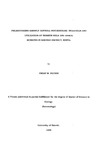| dc.description.abstract | A field based project to study the behaviour and utilization of termite hills and
animal burrows by phlebotomtne sandflies in Baringo District, Kenya was undertaken.
The trapping of sandflles was done in two areas; around Perkerra and Rabat Primary
Schools. Sandflies were trapped with sticky papers inserted into entry-exit traps (Yuval
et al..1986). The traps were set from 1800h to 2400h and again from 2400h to 0600h.
For every six hours. 12 traps were set out at each of the two trapp1ng sites. In a full
night's collection a total of 24 traps were set.
In both areas sandfly abundance and activities were studied in termite hills and
animal burrows. Perkerra produced more sandflies than Rabat, 7.132 (68.6%) and
3.166 (3l.4%). respectively. Perkerra area had more Phlebotomus duboscqi than Rabat,
57 and 22. respectively. Rabat seemed more suited for the breeding of P. martini than
Perkerra, 376 and 66. respectively. More sandflies were caught in termite hills (59.1%)
than in animal burrows (41:0%). P. martini was found to be more abundant in termite
hills than animal burrows. (~.6%) and (0.6%-,."r.-fespectively. P. duboscqi were more
abundant in animal burrows than in termite hJII.s. 0.7% and 0.02%. respectively.
Among the Sergentomyia species; S. schwetzi; S. antennata and S. bedfordi were more
abundant in termite hills. S. ciudet. S. adleri and S. squamipleusts were caught in
greater numbers of animal burrows. P. rodhaini a species which is closely related to P.
duboscqi, was more abundant in animal burrows. Sugar feeding by phlebotomtne
sandflles occured in the two trapping periods (t.e 1800h-2400h and 2400h-0600h).
Most sugar-fed sandflies were collected after midnight in both animal burrows and
termite hills. Bloodfeeding patterns of female sandflies in both Perkerra and Rabat
showed that more bloodfed sandflies were caught in the first half of the night. At
Perkerra, where a total of 74 bloodfed sandflles were caught. 65 (87.8%) were caught in
the first half of the night compared to 9 (12.2%) caught in the second half. With a total
of 73 bloodfed female sandflies collected at Rabat, 53 (72.6%) were captured in the first
half of the night and 20 (27.6%) in the second half. Out of a to!al of 1.661 female
sandflies captured in animal burrows. 164 (9.9%) were parous and 1091 (65.6%) were
nulliparous. In termite hills. where a total of 2.593 female sandfltes were collected. 255
(9.8%) were parous and 2.132 (82.2%) nulliparous. Also in animal burrows. where a
total of 2.640 male sandfltes were collected. 2.443 (92.5%) had rotated genitalia and 197
(7.5%) unrotated. For those males trapped in termite hills. where a total of 3.499 males
were trapped. 3.241 (92.6%) had rotated genitalia and 258 (7.4%) unrotated.
By the end of the study period. it was observed that resting sites of the vectors of
leishmaniasis could be identified. Their feeding behaviours were also established with
the information on sugar and bloodfeedmg
patterns. This may lead to control measures being aimed at these resting sites. | en |

